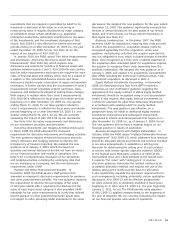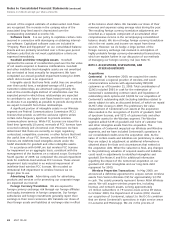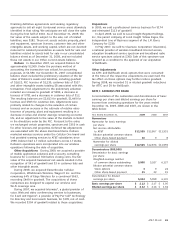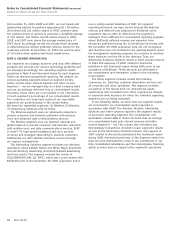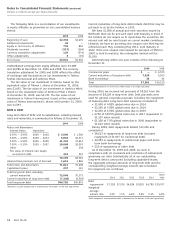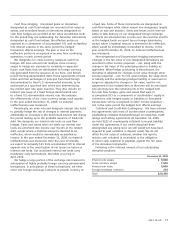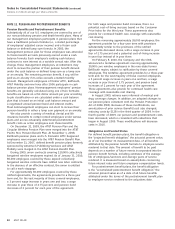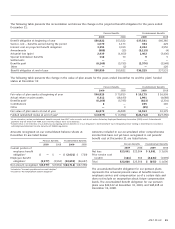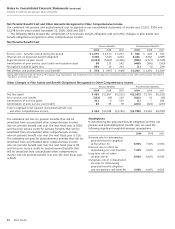AT&T Wireless 2009 Annual Report Download - page 77
Download and view the complete annual report
Please find page 77 of the 2009 AT&T Wireless annual report below. You can navigate through the pages in the report by either clicking on the pages listed below, or by using the keyword search tool below to find specific information within the annual report.
AT&T 09 AR 75
failure by AT&T or any subsidiary to pay when due other
debt above a threshold amount that results in acceleration
of that debt (commonly referred to as “cross-acceleration”)
or commencement by a creditor of enforcement proceedings
within a specified period after a monetary judgment above
a threshold amount has become final; acquisition by any
person of beneficial ownership of more than 50% of AT&T
common shares or a change of more than a majority of
AT&T’s directors in any 24-month period other than as
elected by the remaining directors (commonly referred to as
a “change-in-control”); material breaches of representations
in the agreement; failure to comply with the negative pledge
or debt-to-EBITDA ratio covenants described above; failure
to comply with other covenants for a specified period after
notice; failure by AT&T or certain affiliates to make certain
minimum funding payments under Employee Retirement
Income Security Act of 1974, as amended (ERISA); and
specified events of bankruptcy or insolvency.
NOTE 9. FAIR VALUE MEASUREMENTS AND DISCLOSURE
GAAP standards require disclosures for financial assets and
liabilities that are remeasured at fair value at least annually.
GAAP standards establish a three-tier fair value hierarchy,
which prioritizes the inputs used in measuring fair value.
The Fair Value Measurement and Disclosure framework
provides a fair value hierarchy that prioritizes the inputs to
valuation techniques used to measure fair value. The hierarchy
gives the highest priority to unadjusted quoted prices in
active markets for identical assets or liabilities (Level 1
measurements) and the lowest priority to unobservable
inputs (Level 3 measurements). The three levels of the fair
value hierarchy under Fair Value Measurement and
Disclosure are described below:
Credit Facility We have a five-year credit agreement with a
syndicate of investment and commercial banks. In June 2009,
one of the participating banks, Lehman Brothers Bank, Inc.,
which had declared bankruptcy, terminated its lending
commitment of $535 and withdrew from the agreement.
As a result of this termination, the outstanding commitments
under the agreement were reduced from a total of $10,000
to $9,465. We still have the right to increase commitments
up to an additional $2,535 provided no event of default under
the credit agreement has occurred. The current agreement
will expire in July 2011. We also have the right to terminate,
in whole or in part, amounts committed by the lenders
under this agreement in excess of any outstanding advances;
however, any such terminated commitments may not be
reinstated. Advances under this agreement may be used for
general corporate purposes, including support of commercial
paper borrowings and other short-term borrowings.
There is no material adverse change provision governing
the drawdown of advances under this credit agreement.
This agreement contains a negative pledge covenant,
which requires that, if at any time we or a subsidiary pledges
assets or otherwise permits a lien on its properties, advances
under this agreement will be ratably secured, subject to
specified exceptions. We must maintain a debt-to-EBITDA
(earnings before interest, income taxes, depreciation and
amortization, and other modifications described in the
agreement) financial ratio covenant of not more than
three-to-one as of the last day of each fiscal quarter for
the four quarters then ended. We comply with all covenants
under the agreement. At December 31, 2009, we had no
borrowings outstanding under this agreement.
Defaults under the agreement, which would permit the
lenders to accelerate required payment, include nonpayment
of principal or interest beyond any applicable grace period;
LEVEL 1 Inputs to the valuation methodology are unadjusted quoted prices for identical assets or liabilities in active markets
that AT&T has the ability to access.
LEVEL 2 Inputs to the valuation methodology include:
• Quotedpricesforsimilarassetsandliabilitiesinactivemarkets;
• Quotedpricesforidenticalorsimilarassetsorliabilitiesininactivemarkets;
• Inputsotherthanquotedmarketpricesthatareobservablefortheassetorliability;
• Inputsthatarederivedprincipallyfromorcorroboratedbyobservablemarketdatabycorrelationorothermeans.
If the asset or liability has a specified (contractual) term, the Level 2 input must be observable for substantially the
full term of the asset or liability.
LEVEL 3 Inputs to the valuation methodology are unobservable and significant to the fair value measurement.
• Fairvalueisoftenbasedoninternallydevelopedmodelsinwhichtherearefew,ifany,externalobservations.


